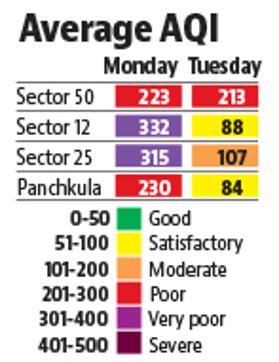Chandigarh gets a breather as air quality improves due to winds
The average AQI remained at 107 on Tuesday, just past the 100 mark, placing it in the moderate bracket
The air quality index (AQI), which had reached a high of 335 on Monday dropped by more than 50% on Tuesday, coming down to 105 at 4pm at the continuous ambient air quality monitoring station in Sector 25. The average AQI remained at 107 on Tuesday, just past the 100 mark, placing it in the moderate bracket. AQI between 101 and 200 is classified as moderate, leading to breathing discomfort in people with lung and heart diseases.

Explaining how the AQI dipped so sharply in a short duration, scientist at India Meteorological Department (IMD) Chandigarh, Shivinder Singh said, “Around Monday night, the airlock created because of anticyclonic movement was opened, and a jetstream was created going towards the South East. This created turbulence in the air, leading to vertical movement between the lower layers and top layers of the air helping to disperse the pollutants.”

He added that even though the wind speed didn’t exceed 20km/h at the IMD observatory, the pollutants were blown away. “Coming from the North Western side, these were dry winds and also reduced the humidity of the air, which was one of the reasons behind the pollutants not getting dispersed properly,” the IMD official said, adding that the satellite imagery showed the cloud of smog shifting towards the South East.
Chandigarh pollution control committee (CPCC) vice-president Debendra Dalai besides the meteorological changes, farmers had also stopped burning stubble in their fields, bringing down the pollution levels. “On Monday night, I visited the farms in and around Chandigarh. No live fires were seen by my team anywhere,” he said.
Dalai further said, “We spoke to some farmers, who said they had no option but to resort to stubble burning as no agricultural labourers are available and burning is cheaper and practical for them. Next year we need to work with the Punjab and Haryana government to provide facilities to farmers to dispose off their stubble properly.”
He added that PM10 had now replaced PM 2.5 as the chief pollutant. “PM10 is the particulate matter with a bigger diameter and is less harmful as compared to PM 2.5,” he said.
Panchkula AQI drops below 100
Even as the air in Chandigarh is still moderately polluted, the average AQI in Panchkula dropped down to 84 in Panchkula, making the quality satisfactory. Panchkula has fared better than Chandigarh. As per the readings taken at the Haryana state pollution control board monitoring station in Sector 6, Panchkula, the AQI had reached 280 a day after Diwali. However, it fell down to 188 the very next day, and mostly remained below 200 after that.
Speaking about this, IMD director Surender Paul said, “Panchkula is situated in close proximity to the hilly area. Due to this, more vertical circulation in the air can be expected owing to pressure differences, dispersing the pollutants better.” Dalai said that even though the vehicle density in Panchkula was less, the fact that the pollutants were dispersed sooner here points to more turbulence in the air here.






